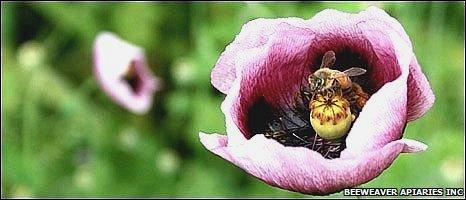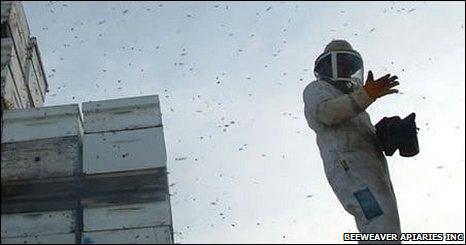Infections link to bees decline
- Published

A combination of fungi and viruses could be reponsible
US researchers claim to have identified a new potential cause for Colony Collapse Disorder (CCD) in honeybees.
The disease is responsible for wiping out many beekeepers' entire colonies over the past few years.
Scientists from the US Department of Agriculture say the pathogens to blame are a fungus and a family of viruses.
The results of the study were presented at the 110th General Meeting of the American Society for Microbiology in San Diego, California.
Dr Jay Evans of the USDA Agricultural Research Service, a researcher on the study, says that when these two very different pathogens show up together, "there is a significant correlation with colony decline".
Daniel Weaver, a commercial beekeeper from Texas and head of the BeeWeaver Apiaries Inc, remembers the shock he experienced when he opened his hives in the early spring of 2007 - only to find them empty.
"There was only a queen and ten or twelve bees left in a hive, clustered in one corner. There were broods, but very few of adult bees.
"And there were no signs of poisoning or any other signs of acute mortality - there were no dead bees on the bottom of the hive or outside the hive," said Mr Weaver.
Other US beekeepers, many of whom have been in the business for a long time and have always had normal, healthy bee colonies, started noticing a similar problem at about the same time.
Some had lost up to 90% of their bee populations, and every year since 2006 many have been reporting average losses of 30-35% of hives.
Fungi and viruses
When beekeepers sounded the alarm in 2007, scientists started looking for a cause of the mysterious disease.
They began to collect samples, primarily looking at sick bees from California and Florida, where most of the commercial pollination takes place in the US, and checking them visually for any signs of a problem.
"The most puzzling thing was that the bees [we collected] didn't show any of the pathologies or signs of disease - they looked perfectly healthy," said Dr Evans to the BBC.
After having screened the samples, the researchers found that there was a higher presence of a fungus Nosema cerenae in infected colonies.
But it was only recently that they were able to determine that it is when bees are infected both with Nosema and with a group of RNA viruses that it is likely to lead to a collapse of a colony, said Dr Evans.
To prove their theory about a certain synergy between the two pathogens, the scientists tried to trigger the decline of a honeybee colony artificially.
"We've known for some time that the viruses are not good for the bees' health, that they cause some visible symptoms like paralysis of the bees, shivering or inability to fly," explained Dr Evans.
But getting the entire colony sick was tricky, he said.
"You have to infect bees with a sort of natural level compared to what's going on in the field and then more or less wait around to see how that translates into a colony effect like a colony collapse or decline," said the researcher.

US beekeepers sounded the alarm in 2007
So how do bees get CCD? Dr Evans believes the infection is spread primarily through pollen on flowers.
Commercial beekeepers in the US tend to move their bees around the country in lorries, renting them to farmers to pollinate almonds in California, oranges in Florida and blueberries in Maine. They then bring them home - often in some other part of the US.
When a sick bee leaves a virus on a plant, it is very likely that all other buzzing visitors will get infected - and bring the disease to their hive, elsewhere in the country.
"Once the viruses become prevalent in a colony, they spread quite rapidly both by contact among the bees and often by a parasitic [Varroa destructor] mite that lives on them.
"We've been able to see the viruses move within that mite and actually be transmitted from bee to bee by the mite," said Dr Evans.
As for the fungus, it is transferred by the insects' excretions, he said.
"Nosema ceranae will germinate in the stomach of the bees, work its way into the rest of the body and exit when it's excreted. So when the sick bees defecate in the colony or near a colony, other bees accidentally pick up the spores of the fungus and ingest them - and that restarts the cycle," explained the scientist.
But some believe the fungus and viruses are not the primary causes of CCD.
David Mendes, the president of the American Beekeeping Federation, says that biological pathogens are certainly involved - but that there might be something that affects the bees' immune system in the first place that then allows these pathogens to infect them more easily.
"It's a bit of a chicken-and-egg question: are the fungi and viruses a problem or are they a symptom? Do they come in only when the health of the bees is in some jeopardy? I think the bees get sick because of a combination of factors," said Mr Mendes.
He believes that it is mostly about nutrition - in particular, the bees' inability to process certain foods.
And the pesticides are to blame for that, he says.
A bleak future?
"The whole approach to controlling pests with pesticides has really shifted [in the past few years] - for instance, now corn seeds, before they are planted, are dipped in pesticides," said Mr Mendes.
"There's research that says that it's not supposed to affect the pollen and the fruit - well, we've done some analysis with our citrus trees and we have found levels of the poison in the pollen that the bees are feeding to their young."
Whatever the cause of CCD, Dr Evans believes the cure isn't in sight just yet.
The main thing, he says, is for beekeepers to really focus on the nutrition of their colony in the autumn.
"Nosema fungi respond well to improved nutrition, so supplementing the bees' diet with pollen and nectar resources in the fall will allow them to maintain more nectar as they go into the winter," he said.
Some beekeepers also feed their bees more protein. Others use a chemical treatment for the fungi, but scientists warn it is only a short-term solution.
As for the viruses - there are beekeepers like Daniel Weaver, who only use bee queens from his own colony, selecting them for genetic resistance to Varroa mites and RNA viruses.
He says that this method has helped him obtain much lower levels of CCD incidence in his colonies - an experience consistent with the results reported in the recent study.
"That pattern of our varroa [mites] and virus resistant bees not succumbing to CCD is all the more important when we can say that colonies headed by queens produced by other queen breeders but operated under the same environmental conditions - and right next door to hives headed by our queens - did succumb to CCD," said Mr Weaver.
Until the cure is found, it is not just the beekeepers who are suffering - agricultural companies and of course consumers who buy their products have been affected as well.
Mr Weaver says he just hopes the buzzing honey workers will continue to fight CCD - because without them, the world just wouldn't be the same.
"Without bees, our world would be a very dreary place to live. So many delicious fruits wouldn't be available and so many wonderful plants wouldn't be able to propagate and reproduce," he said.
"A very dull and dreary place indeed."